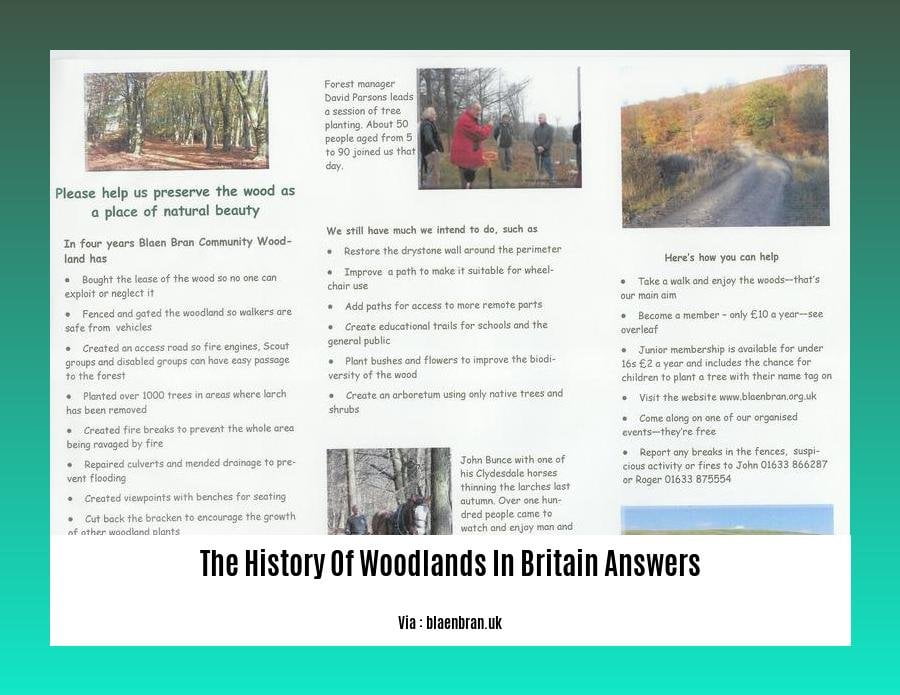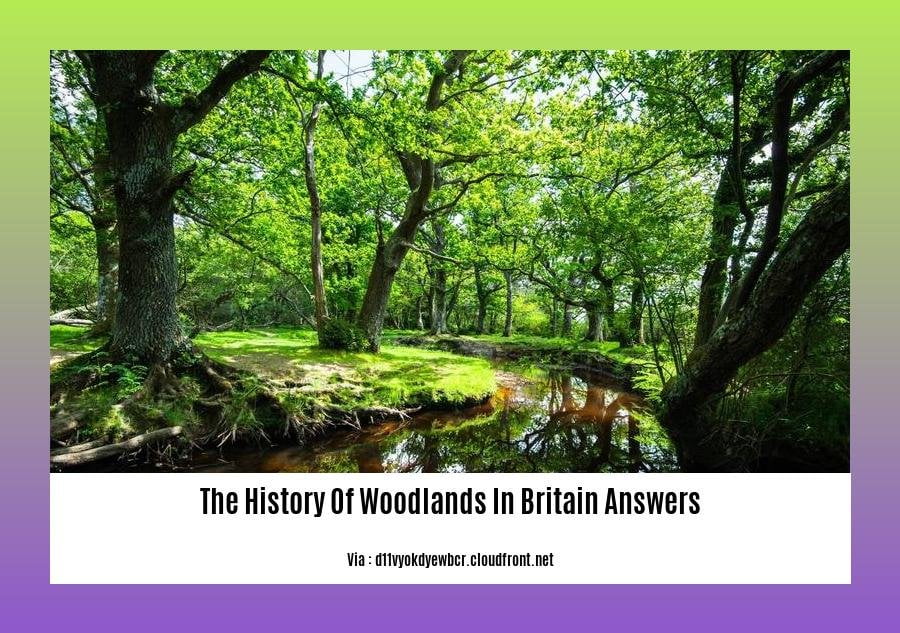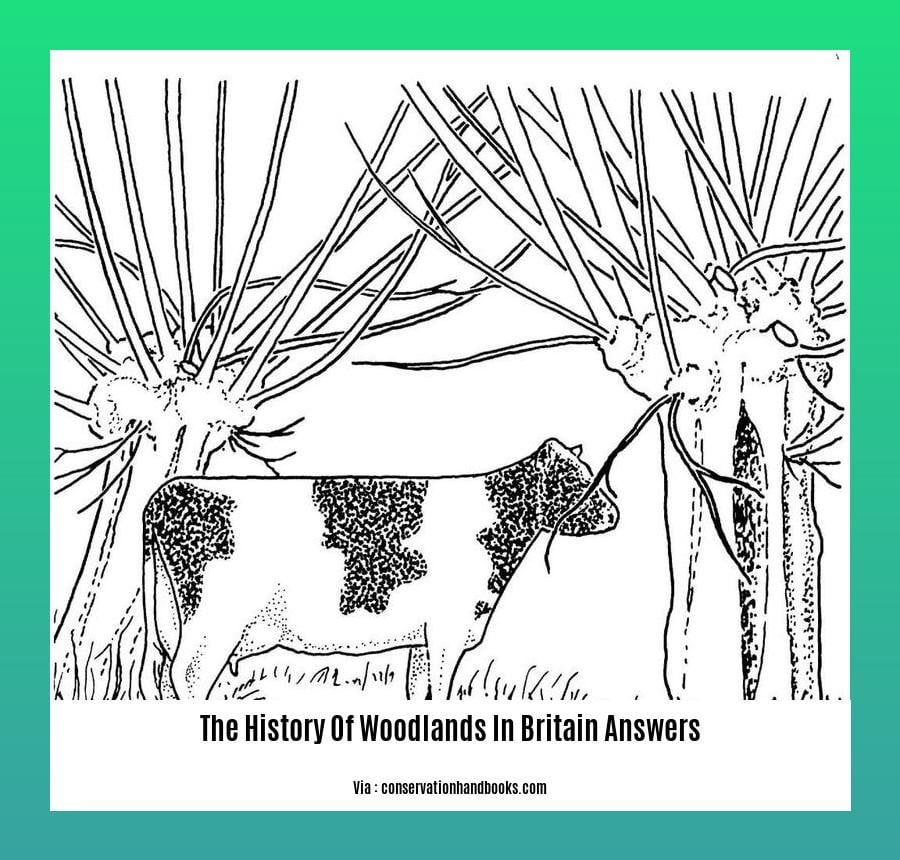Embark on a journey through time as we delve into the history of woodlands in Britain. Their story is an intricate tapestry woven with ancient tales, ecological wonders, and profound cultural significance. From the vast primaeval forests that once carpeted the land to the managed woodlands we cherish today, these natural havens hold a wealth of secrets waiting to be unveiled. Join us as we unravel the past to preserve the future of Britain’s cherished woodlands in [Delving into the History of Woodlands in Britain: Unraveling the Past, Preserving the Future].
Key Takeaways:
- Britain’s woodland history is relatively short, dating back to the end of the last glaciation.
- Woodlands were once widespread in Britain, covering around 15% of the land in 1086.
- Intense woodland clearance occurred in Britain, coinciding with an agricultural depression.
- By the 20th century, woodland covered only 5% of Britain, with coppicing declining and conifers being planted in estates.
Woodlands in Britain: A Journey Through Time (Answers)

Uncovering the Roots of British Woodlands
Britain’s woodlands boast a fascinating history, deeply intertwined with human civilization and geological shifts. Let’s embark on a journey to understand the evolution of these natural treasures:
A Green Canvas Emerges
In the wake of the last ice age, Britain’s landscape transformed. Around 10,000 BC, as temperatures rose, pioneer trees, such as birch and pine, colonized the barren land, marking the beginning of woodland expansion.
By 4000 BC, Britain was blanketed in a vast expanse of mixed deciduous woodland, teeming with oak, elm, hazel, and lime trees. These woodlands provided shelter, sustenance, and resources for the early inhabitants of the land.
A Tapestry of Woodland Uses
Woodlands served a multitude of purposes throughout history. They were a source of timber for construction, fuel for warmth, and food through hunting and gathering.
Woodlands also played a vital role in agriculture, providing grazing land for livestock and pannage (the right to feed pigs on fallen acorns and beechnuts) for the local communities.
The Great Woodland Clearance
From the medieval period onwards, Britain experienced a significant decline in woodland cover due to agricultural expansion and the growing demand for timber.
By the 16th century, only 15% of England’s land area was covered by woodland. This clearance had far-reaching ecological consequences, leading to soil erosion, flooding, and a decline in biodiversity.
Reforestation and Conservation Efforts
In the 19th century, awareness of the importance of woodlands grew, leading to the establishment of the Forestry Commission in 1919.
Since then, there have been concerted efforts to conserve and expand Britain’s woodland heritage, resulting in an increase in woodland cover to around 13% of the land area today.
Woodlands: Our Enduring Legacy
Britain’s woodlands are not just remnants of the past; they are dynamic ecosystems that continue to shape our present and future.
They provide a haven for wildlife, regulate the climate, protect water resources, and offer countless recreational and educational opportunities.
Questions to Ponder:
How can we balance the need for development with the preservation of our precious woodland heritage?
What innovative approaches can we adopt to ensure the resilience of our woodlands in the face of climate change and other environmental challenges?
Dive into the rich heritage of Korean skincare with the history of Whoo Korea, a renowned brand rooted in ancient royal beauty secrets.
Explore the fascinating timeline history of the church from its humble beginnings to its profound impact on society throughout the ages.
Witness the most awe-inspiring goals in football history as we countdown the which is the best goal in football history that left fans around the world in awe.
Unravel the secrets of the most dangerous batsman in cricket history, whose power and precision at the crease sent shivers down the spines of bowlers worldwide, in our in-depth analysis of who is the most dangerous batsman in cricket history.
**Early Humans and Woodlands: A Story of Influence**
Early humans heavily influenced the development of woodlands through activities such as hunting, gathering, and agriculture.
Let’s journey back in time to the Pleistocene era, when the shadowy figures of early humans first wandered into Britain’s woodlands. These early inhabitants were far from passive observers; their activities, like brushstrokes on a canvas, left an enduring mark on the landscapes they encountered.
Imagine them, armed with rudimentary tools and a spirit of curiosity, venturing into these vast natural cathedrals. The woodlands offered a smorgasbord of resources, from succulent fruits and nuts to elusive game. Every hunt, every gathering expedition, became a subtle dance between humans and their surroundings, shaping the very ecosystems they relied on.
Over millennia, as human populations grew and their skills sharpened, their impact on woodlands became more profound. They cleared patches of forest for agriculture, introducing new plant species that would forever alter the woodland composition. This interplay between humans and woodlands was a continuous feedback loop, a dynamic dance that molded the very essence of these natural sanctuaries.
Key Takeaways:
Early humans were instrumental in shaping Britain’s woodlands through hunting, gathering, and agriculture.
Their activities introduced new plant species, altering the woodland composition and biodiversity.
The relationship between humans and woodlands was a dynamic one, with each influencing the other over time.
References:
Woodlands have been actively managed by humans for centuries, with different historical periods seeing different approaches to woodland management.

Woodlands have been actively managed by humans for centuries, with various historical periods shaping the ways in which they have been used and preserved. Let’s delve into the fascinating journey of these woodland ecosystems and how human interactions have influenced their evolution:
Early Human Influence
- In the early days, humans primarily interacted with woodlands for sustenance, hunting, and shelter. They relied on the natural resources found within these ecosystems for food, firewood, and building materials.
Medieval Period: Demand for Timber and Land
- During the medieval era, the demand for timber and land for agriculture led to significant changes in woodland management. Large-scale clearance occurred to make way for farmland and provide timber for construction and fuel.
Industrial Revolution: Exploitation and Degradation
- The Industrial Revolution brought about a surge in demand for wood, leading to extensive deforestation and degradation of woodland ecosystems. Woodlands were cleared for mining, charcoal production, and other industrial activities.
Conservation Efforts Emerge
- In the 19th century, awareness of the ecological importance of woodlands grew, leading to the establishment of organizations dedicated to conservation and sustainable management. Efforts were made to protect ancient woodlands and reforestation projects were initiated.
Modern Approaches: Balancing Needs
- Today, woodland management focuses on balancing the need for timber, recreation, and conservation. Sustainable forestry practices aim to minimize the impact on ecosystems while meeting the demand for wood products.
Key Takeaways:
Woodlands have a long history of human interaction, dating back to early human reliance on their resources.
Different historical periods have seen varying approaches to woodland management, from clearance for agriculture to conservation efforts.
The Industrial Revolution led to extensive deforestation, highlighting the need for sustainable practices.
Modern woodland management seeks to balance the demands for timber, recreation, and conservation.
Citations:
Woodland Trust: Ancient Woodland
Forestry Commission: History of Woodlands in Britain
Woodlands have played a vital role in British culture and society throughout history, providing resources, inspiration, and places for recreation.
From the prehistoric era, when ancient Britons relied on woodland ecosystems for survival, to the thriving communities that developed around these bountiful landscapes, woodlands have been deeply intertwined with the cultural and societal fabric of Britain.
In the tapestry of British history and tradition, woodlands have served as a rich source of inspiration for artists, writers, and musicians alike. The enchanting beauty and tranquility of these natural havens have captured the imagination of countless creatives, inspiring them to create masterpieces that celebrate the wonders of the woodland realm.
Economic and Practical Significance:
Resources: Woodlands have historically provided a wealth of resources, including timber for building and construction, fuel for heating and cooking, and food in the form of nuts, berries, and game.
Livelihoods: Woodlands have supported numerous traditional livelihoods, such as forestry, hunting, and charcoal production, contributing to the economic well-being of rural communities.
Cultural and Recreational Value:
Recreation: Woodlands have long been cherished as places for recreation and leisure activities, offering opportunities for walking, hunting, and other outdoor pursuits.
Inspiration: The beauty and tranquility of woodlands have inspired countless works of art, literature, and music, enriching British culture and heritage.
Ecological Importance:
Biodiversity: Woodlands are home to a rich diversity of plant and animal species, providing vital habitats for many rare and endangered species.
Carbon Sequestration: Woodlands play a crucial role in carbon sequestration, helping to mitigate climate change by absorbing carbon dioxide from the atmosphere.
Water Filtration: Woodlands help to filter and regulate water supplies, ensuring the quality and availability of water for both human consumption and wildlife.
Key Takeaways:
- Woodlands have been a vital part of British culture and society for millennia, providing resources, inspiration, and places for recreation.
- Woodlands have supported traditional livelihoods and contributed to the economic well-being of rural communities.
- The beauty and tranquility of woodlands have inspired countless works of art, literature, and music.
- Woodlands are home to a rich diversity of plant and animal species and play a crucial role in carbon sequestration and water filtration.
- Conservation efforts are essential to protect the remaining ancient woodlands and ensure their continued benefits for future generations.
Citations:
[1] Ancient Woodland | Woodland Trust
[2] Ancient Woodland – British Habitats – Woodland Trust
FAQ
Q1: What is the history of woodlands in Britain?
A1: Woodlands in Britain have existed since the end of the last ice age, around 10,000 years ago. They have played a crucial role in human history, providing resources, shelter, and habitat for wildlife. However, they have faced various pressures in recent centuries, including deforestation for agriculture, urbanization, and development.
Q2: What are ancient woodlands?
A2: Ancient woodlands are woodlands that have existed continuously since 1600 in England, Wales, and Northern Ireland, and 1750 in Scotland. They are particularly valuable for their biodiversity and cultural heritage, supporting a wide range of rare and endangered species.
Q3: Why are ancient woodlands important?
A3: Ancient woodlands are important for several reasons. They support a diverse range of plant and animal species, act as carbon sinks, and have cultural and historical significance. Preserving and managing these woodlands is essential for maintaining the UK’s natural heritage and ensuring the survival of many threatened species.
Q4: What threats do ancient woodlands face?
A4: Ancient woodlands face several threats, including development, agriculture, and climate change. Development can lead to the loss or fragmentation of ancient woodland, while agriculture can result in the conversion of woodland to farmland. Climate change can also have a significant impact on ancient woodlands, leading to changes in species composition and distribution.
Q5: What is being done to protect ancient woodlands?
A5: Various efforts are underway to protect ancient woodlands in the UK. The Woodland Trust, a conservation charity, plays a significant role in acquiring and managing ancient woodlands, as well as raising awareness of their importance and promoting sustainable woodland management practices.
- Master Parts of Pants:Perfect Fit Guide - June 14, 2025
- Unlock Your Vinyl: Parts of a Record Player Guide - June 14, 2025
- Shop Authentic Southwestern Clothing: A Guide - June 14, 2025
















